
14 minute read
Publication Highlights
During the past year, we have been pleased to witness the completion and publication of several exciting and innovative studies led by members of the Sabri Ülker Center.
We feel that these new insights into the interfaces between nutrient sensing and metabolism, cellular function, and ultimately human diseases have not only furthered our scientific knowledge of these areas but have suggested new pathways for potential therapeutic interventions.
Advertisement
The highlight of the year was a groundbreaking study led by postdoctoral fellow Scott Widenmaier that added an entirely new view to our understanding of the regulation of metabolism of cholesterol, one of the key molecules involved in cellular function as well as whole-body metabolism. Because of its significant role in major maladies like cardiovascular and metabolic disease, cholesterol metabolism has long been a focus of intensive study, yet our results reveal for the first time a mechanism by which cells respond to high intracellular cholesterol levels and complement a long-standing paradigm of cholesterol regulation.
Another critical study revealed a previously unknown function of molecular quality control systems in determining the metabolic function of adipose tissue that has been recently appreciated as a key contributor to whole-body energy balance and a potential target of treatments for obesity and metabolic diseases. We also published a study providing a novel view of the relationships among nutrient intake and metabolism in determining health and lifespan in aging animals illustrating a path to extend metabolic health throughout life.
These and several other publications including important collaborative studies continue our track record of contributions to the science of metabolism as it relates to human disease.
PUBLICATION HIGHLIGHTS “ Yin-Yang of Cholesterol Management ”
Nrf1 Is an ER Membrane Sensor That Is Central to Cholesterol Homeostasis Widenmaier SB, Snyder NA, Nguyen TB, Arduini A, Lee GY, Arruda AP, Saksi J, Bartelt A, Hotamışlıgil GS Cell, November 2017
Cholesterol is an essential component of cellular membranes, and its concentration has profound effects on membrane properties, cellular
processes, and organismal function. Cholesterol is highly responsive to nutrients and genetic factors in humans, and dysregulated levels are a strong risk factor for cardiovascular disease and other maladies.
While the harmful effects of cholesterol have been predominantly linked to its increased levels in the circulation, it is within the cells that many critical processes take place and the metabolism of cholesterol must be tightly controlled for proper function. A well-established paradigm in cell biology is the system by which cells respond to low cholesterol levels. The transcription factor serum response element-binding protein-2 (SREBP2) is synthesized as an inactive precursor form that is associated with the
ER membrane. Under conditions of low cholesterol concentration in the endoplasmic reticulum (ER) membrane, SREBP undergoes proteolytic cleavage allowing the transcription activation domain of the protein to be translocated to the nucleus where it promotes expression of enzymes required for cholesterol synthesis, thus restoring cholesterol concentrations.
However, parallel mechanisms that respond to high cholesterol content in the cells have not been previously elucidated. In our earlier work, we have identified a critical role for ER in metabolic regulation beyond its classic function in protein quality control and trafficking. Interestingly, the ER in all cells contains the lowest amount of cholesterol, hence rendering this membrane structure the potential to serve as a sensor of cholesterol. Since it is paramount that cells must be protected from excess cholesterol, which is highly toxic, we envisioned that a response system to protect against the rise in cellular cholesterol must exist and may reside in the ER. This study describes the discovery of a novel mechanism for such sensing and ameliorating high cholesterol levels in cells and protection against the damage due to its accumulation. We demonstrate that the transcription factor nuclear factor erythroid factor-2, like-1 (Nfe2l1, also known as Nrf1) is localized in the ER and contains structural elements to recognize cholesterol. Interestingly, Nrf1 protein levels are greatly increased by exposure
of cells to cholesterol, as well as by feeding animals a high cholesterol diet. Most strikingly, livers of mice with a specific deletion of hepatic Nrf1 expression (Nrf1 L-KO mice) accumulated massive amounts of lipids, primarily cholesterol-derived species, when fed a high cholesterol diet. This striking metabolic
abnormality could be reversed by replenishing Nrf1 in deficient livers strongly implicating Nrf1 as a key regulator to restrain cholesterol accumulation and related damage.
These observations raised the question of how Nrf1 senses and responds to cholesterol levels. Our results show that Nrf1 directly senses ER cholesterol via binding to a specific domain in the protein, an essential feature that regulates multiple aspects of Nrf1 behavior and function including its translocation to the nucleus. In the presence of elevated cholesterol, Nrf1 is excluded from the nucleus, which unleashes the defensive countermeasures program to defend against cholesterol excess. We also identified the immunometabolic components of this adaptive response and identified a candidate molecule directly targeted by Nrf1.
Taken together, these results suggest that Nrf1 is a sensor for high cholesterol that functions in a complementary, opposite way to low cholesterol sensing by the SREBP2 system. These counterbalancing systems permit fine-tuning of cholesterol levels, critical to normal cellular functions. We believe these critical observations fill an important gap in understanding cholesterol metabolism and the cellular- or organ-based adaptive responses to nutrient fluctuations. Targeting of these built-in adaptive responses, such as the case with Nrf1, could provide a novel approach to ameliorate pathologies related to cholesterol accumulation and improve treatment of metabolic diseases.
PUBLICATION HIGHLIGHTS “ Lifelong Metabolic Health ”
Uncoupling of Metabolic Health from Longevity through Genetic Alteration of Adipose Tissue Lipid Binding Proteins Charles KN, Li M-D, Engin F, Arruda AP, Inouye K, Hotamışlıgil GS Cell Reports, October 2017
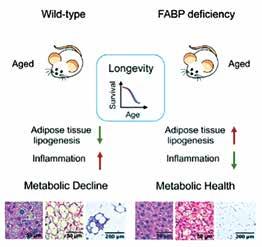
Evolutionarily conserved pathways that impact longevity and aging (such as insulin and insulin-like growth factor pathways) overlap with systems that respond to nutrients and regulate metabolism. Furthermore, many studies have confirmed clear connections between energy balance, metabolic health, and longevity: overnutrition and obesity are associated with impaired metabolic health and reduced longevity whereas caloric restriction (CR) promotes metabolic health and increased longevity. However, even among “healthy” weight individuals, risk of metabolic dysfunctions increases with age. Furthermore, while it is well known that inflammation appears and metabolic health typically deteriorates with age, it is unclear whether these problems could be prevented throughout life and if such an intervention would extend healthspan and/or lifespan.
In this study, led by joint first authors Khanichi Charles and Min-Dian Li, we first demonstrate that mice that are deficient in fatty acid binding proteins FABP4 (aP2) and FABP5 (mal1) are markedly resistant to age-related obesity, inflammation, insulin resistance, diabetes, fatty liver disease, and brown adipose tissue degeneration. This preservation of metabolic health was evident even after long-term exposure to a high-fat, high-calorie diet. From earlier studies, we also know that deficiency of FABP4 and FABP5 also protects against atherosclerosis and extends survival in apolipoprotein E-deficient mice. This finding demonstrates that lipid binding proteins are control regulators of metabolic health and do so in a sustained manner. Thus, the FABP-deficient mice provide a useful model to address the question of whether preservation of metabolic health contributes to the extension of lifespan.
Interestingly, we also discovered that FABP deficiency mimics several features of long-term caloric restriction. However, we were surprised to discover that despite the metabolic similarities to the CR regimen, and a remarkable preservation of metabolic health, FABP deficiency did not result in extension of lifespan in mice. Furthermore, FABP deficiency did not result in improvements in measures of cardiac, muscle, or cognitive features of aging mice. FABP deficiency, therefore, represents a unique model in which longevity and most measures of aging are uncoupled from metabolic health. This work may inform future work seeking therapies for metabolic diseases as well as other conditions associated with aging in humans. The ability to extend the number of years that people are healthy would be a highly impactful achievement from a public health perspective. Identification of a potential mechanism and simple interventions to target this mechanism may help us get closer to attaining this goal. FABPs present one attractive target for interventions to preserve metabolic health throughout life.
PUBLICATION HIGHLIGHTS
Survival of Tissue-Resident Memory T Cells Requires Exogenous Lipid Uptake and Metabolism Pan Y, Tian T, Park CO, Lofftus SY, Mei S, Liu X, Luo C, O’Malley JT, Gehad A, Teague JE, Divito SJ, Fuhlbrigge R, Puigserver P, Krueger JG, Hotamışlıgil GS, Clark RA, Kupper TS Nature, March 2017
OT-1
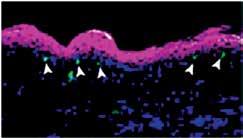
OT-1 Fabp4 –/–/Fabp5 –/–
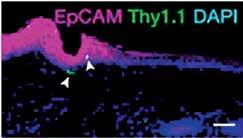
In recent years, it has been recognized that alterations in metabolism in innate and adaptive immune cells occur concomitantly with activation or alterations of the inflammatory phenotype of those cells.
This includes alteration in fatty acid metabolism, and our group has a continuing interest in exploring the roles of fatty acid binding proteins including FABP4 (aP2) and FABP5 (mal1) in modulating metabolism in a variety of cell and organ contexts.
In this collaboration with colleagues at the Dana-Farber Cancer Center, Brigham and Women’s
Hospital, and others, the functions of FABP4 and FABP5 as regulators of the properties of tissue-resident
memory T (T RM ) cells of skin were explored. These cells, which are critical for resistance to infection by various pathogens, express high levels of FABP4 and FABP5 following an infection challenge. Further,
it is demonstrated that T RM cells derived from double-knockout mice that lack expression of both FABP4 and FABP5 are defective in protection from an infection challenge due to impaired survival of the resident T cells. These cells were also defective in utilizing exogenously supplied fatty acids as a fuel source via mitochondrial oxidation, suggesting that fatty acid uptake and oxidation are critical to the long-term survival of the T RM cells.
Increased FABP4 and FABP5 expression and enhanced extracellular fatty acid uptake were also
demonstrated in human T RM cells. The functions of these cells are important in effective vaccine responses, but also contribute to autoimmune pathologies, thus understanding of these key metabolic pathways may inform both of these areas of human medicine and pave the way for new therapeutic approaches.
PUBLICATION HIGHLIGHTS
The Cold-Induced Lipokine 12,13 diHOME Promotes Fatty Acid Transport into Brown Adipose Tissue Lynes MD, Leiria LO, Lundh M, Bartelt A, Shamsi F, Huang TL, Takahashi H, Hirshman MF, Schlein C, Lee A, Baer LA, May FJ, Gao F, Narain NR, Chen EY, Kiebish MA, Cypess AM, Blüher M, Goodyear LJ, Hotamışlıgil GS, Stanford KI, Tseng Y-H Nature Medicine, May 2017
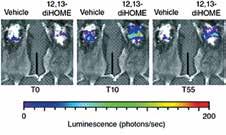
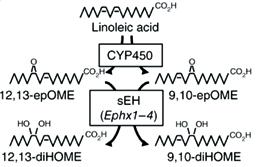

Along with its vital metabolic functions, adipose tissue has been recognized as a rich source of endocrine factors including peptide hormones that have profound effects on whole-body energy homeostasis, affecting diverse properties such as food seeking and satiety as well as insulin sensitivity of other organs such as the liver. Our lab and others also discovered that lipid synthesis in adipose tissue is a source of potent lipid species, termed lipokines, which constitute a new class of metabolic hormones and affect remote tissues.
This paper reports results of a study carried out in collaboration with colleagues at the Joslin Diabetes Center of the Harvard Medical School and others. The objective was to identify additional novel lipokines that might be involved in the regulation of brown adipose tissue (BAT) function. BAT is a specialized form of adipose tissue that is adapted to consume lipids and other fuels to produce heat to maintain body temperature in cold-exposed animals. The enormous capacity of BAT to utilize caloric energy makes it an attractive target for treatment of obesity and related metabolic disorders.
This study employed liquid chromatography–tandem mass spectrometry (LC–MS/MS) to identify and quantify lipid species whose abundance was altered by cold exposure of mice, a treatment known to activate BAT and increase its metabolic activity. This approach identified 12,13-diHOME (12,13-dihydroxy9Z-octadecenoic acid) as a species significantly increased in blood samples of cold-exposed mice. It was also confirmed that the same lipid molecule increased in abundance in blood samples taken from several cold-exposed human subjects. Treatment of mice with 12,13-diHOME led to increased BAT metabolic activity and improved resistance to cold exposure in mice. Mechanistically, one of the functions of 12,13-diHOME is to increase fatty acid uptake via enhancing the activity of fatty acid transporter proteins, consistent with promoting increased availability of a major fuel for thermogenesis. Identification of lipid mediators of thermogenesis like 12,13-diHOME might provide novel and simple approaches to activation of BAT as a potential therapy for obesity.
PUBLICATION HIGHLIGHTS
Inflammation, Metaflammation and Immunometabolic Disorders Hotamışlıgil GS Nature, February 2017
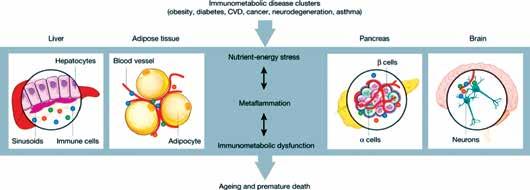
It is now well recognized that close interactions between immune responses and metabolism are required for health and underlie the pathology of many chronic diseases such as obesity and diabetes. This comprehensive analysis provides a synthesis of the field and covers advances in understanding the details of these interactions. Also discussed is emerging human genetics linked to susceptibility to immunometabolic disorders, as well as the exciting translational paths and recent trials of novel pharmaceutical interventions in these disorders.
The Foundations of Immunometabolism and Implications for Health and Disease Hotamışlıgil GS Immunity, September 2017
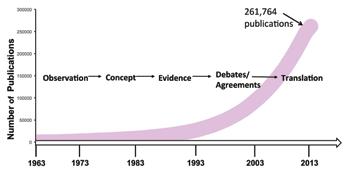
This review provides a historical background and timeline as well as a description of recent advances that have led to a better understanding of the complex interactions between immune responses and metabolism, especially in situations of chronic nutrient excess. Also discussed is the impact of nutritional and metabolic status on the functional programming of immune cells. Immunometabolic interactions underlie the pathology of many significant diseases including obesity, diabetes, and cardiovascular disease, thus continued investigation in this area is vital to the development of novel therapeutic approaches.
PUBLICATION HIGHLIGHTS
ER Stress Promotes Inflammation through Re-Wired Macrophages in Obesity Garfinkel BP and Hotamışlıgil GS Molecular Cell, June 2017
It is well established that inflammation and ER stress are hallmarks of obesity and diabetes and contribute strongly to the pathogenesis of these diseases. Work in our lab and many others has also established endoplasmic reticulum (ER) stress as a major pathway that contributes to the pathology of metabolic diseases. In this Preview, we comment on work by Shan, et al. (Molecular Cell, June 2017) that sheds new light on a molecular mechanism by which ER stress contributes to inflammation and causes cellular and physiological dysfunction associated with obesity. This study showed that activation of the ER stress sensor IRE1α in macrophages associated with adipose tissue in obesity shifts their population toward a pro-inflammatory M1 phenotype. This study reveals that ER stress in immune cells, in addition to adipocytes, compounds the inflammatory state of obese adipose tissue.
Immune Cell Intolerance for Excess Cholesterol Widenmaier SB and Hotamışlıgil GS Immunity, December 2016
The intricate relationship between metabolism and the immune system is critical in health and disease. In this Preview, we comment on recent findings by Ito, et al. (Immunity, December 2016) that describe a new connection between defects in cholesterol metabolism in immune cells and defects in immune response that might contribute to the pathology of autoimmune diseases. It is demonstrated that dysregulated cholesterol levels affect the function of CD11c + cells (antigen-presenting cells that activate T- and B-cells critical in immune responses). Excess cholesterol accumulation in CD11c + cells leads to activation of T-cells and production of antibodies that recognize self-antigens, a hallmark of autoimmune diseases. These findings suggest that treatments that normalize cholesterol control in CD11c + cells could be effective therapies for many common diseases that result from autoimmune responses.
Type I Interferons Interfere with Liver Glucose Metabolism Parlakgül G and Hotamışlıgil GS Cell Metabolism, June 2017
Glucose production by the liver is normally suppressed by insulin when it is secreted in response to feeding. Failure of this response is a major contributor to excess blood glucose levels in diabetes. In this Preview, we comment on recent work by Ghazarian, et al. (Cell Metabolism, June 2017) that proposes a novel connection between obesity, inflammation in the liver, and consequent failure to respond to insulin. These observations suggest that alterations in gut bacteria trigger production of inflammatory mediators including type I interferon by immune cells in the liver, which in turn cause insulin resistance. This paper adds to a body of recent work implicating alterations in gut microbiota in the pathology of metabolic diseases.
Cos7 cells, expressing
‘’Colorful Cell’’ plasmid that targets the following organelles: Mitochondria – green, ER – red, Peroxisome – far red, Nucleus – blue
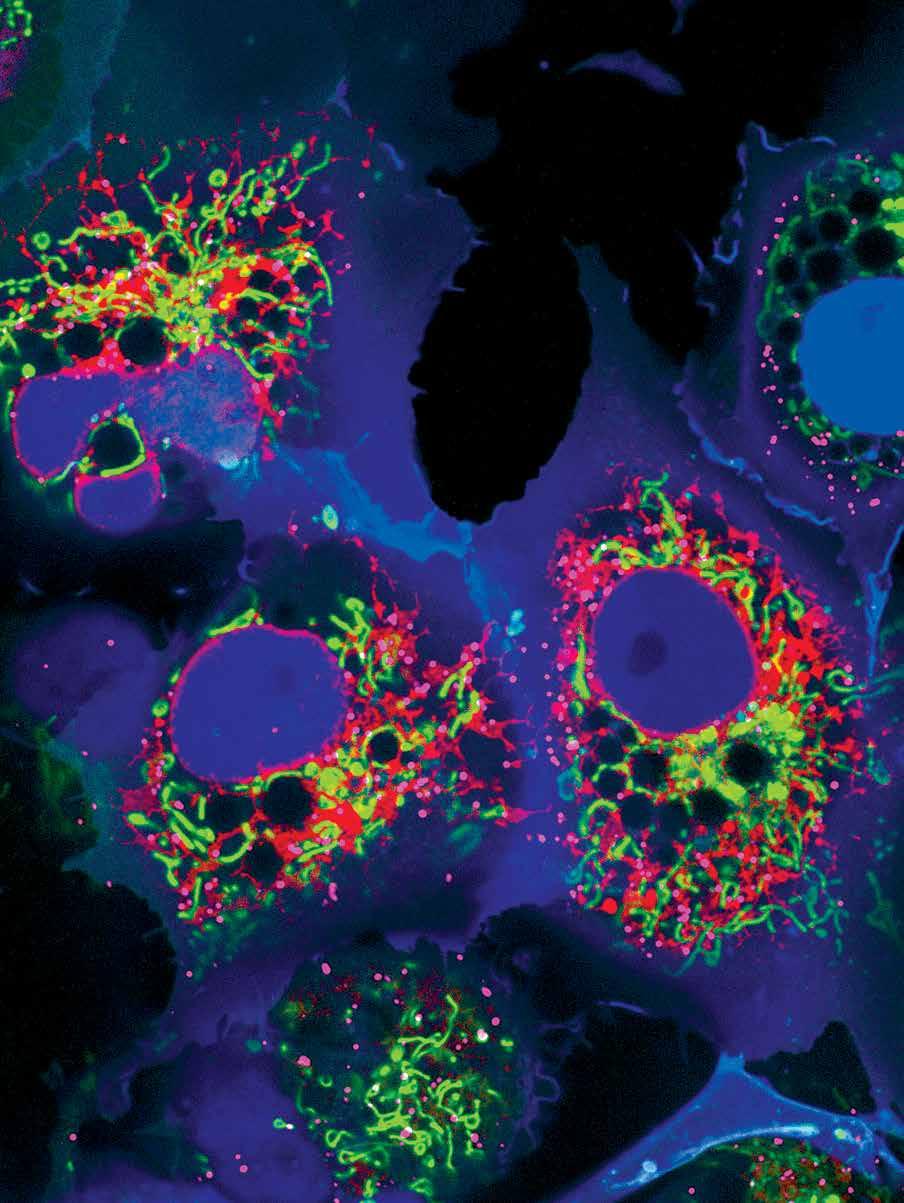
FUTURE WE INVEST IN TRAINING FOR THE

FUTURE








